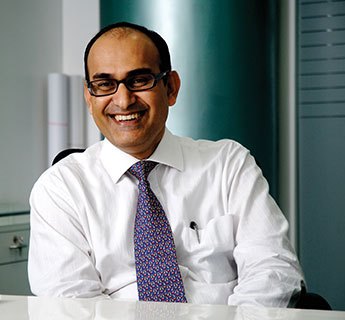 Soumendra Nath Lahiri is the Chief Investment Officer of L&T Mutual fund. He has a rich experience of over 17 years in equity markets in India. He holds a Post Graduate Diploma in Management from IIM Bangalore and a degree in Engineering.
Soumendra Nath Lahiri is the Chief Investment Officer of L&T Mutual fund. He has a rich experience of over 17 years in equity markets in India. He holds a Post Graduate Diploma in Management from IIM Bangalore and a degree in Engineering.
In this exclusive interview with Geojit Insights, Lahiri talks about the overall market condition both nationally and globally. He has also shared his views on the major sectors in Indian market.
Looking at the current banking crisis and rising fed rates, what is your near-term (say 12 months) strategy on your debt portfolio?
Global repricing of developed market tightening is likely to be a continuing medium term headwind for our domestic bond markets in FY19. Along with that, the markets have recently had to deal with the various implications of the ongoing banking crisis, one of them being lack of appetite for government bonds by banks, which is why the bond markets sold off the way they did over the past few months. While we were significantly underweight on duration through most of the last year, we have moved to a neutral position more recently in March 2018, when 10 year g-sec yield hit 7.75% and shorter end rates too moved up sharply. We expect g-sec yields to remain volatile through FY19, and swing between 7.25-8% range, providing good tactical trading opportunities, although we do not believe the risk-reward is favourable for a strategic long duration position given various headwinds. Having said that, apart from g-sec market, we believe the upward move in interest rates in the 1-3 year corporate bond segment actually makes it quite attractive for investors to benefit from the better carry that these segments earn, with relatively little risk of rate hikes by the RBI at least in CY2018.
Investors are looking for alternate investment opportunities, safe assets and defensive bets. Are they missing out on any opportunity lying hidden in their equity or debt portfolio?
Within the debt portion of the investors’ portfolio, there are opportunities available in the shorter end of the yield curve. With yields in the short end of the curve having moved higher and with bank MCLRs expected to move up as well, we believe accrual funds which invest in good quality AAA and AA rated bonds in the 1-3 year segment can provide attractive carry for investors.
What rate trajectory do you expect during the near-term?
FY19 is likely to see wild swings in market expectations about RBI action, given that we are at an inflexion point in terms of RBI monetary policy action, with the next move likely to be a rate hike. However, given that the RBI has been fairly cautious and measured during the rate cutting cycle, we also believe that it will have enough time and space to maintain a stable interest rate regime for longer. Accordingly, we expect policy rates to remain stable through CY2018, and a possible hike somewhere in CY2019 depending on the way the election build-up impacts macroeconomic decision making.
Can the duration investors envisage a point of entry in near future, or will the high rate regime stay for a while?
With 10 year g-sec yields in the 7.50-7.75% range, we believe bulk of the negatives is priced in. We expect yields to swing in a wide 7.25-8% range, thereby providing potential tactical trading opportunities for the dynamically managed duration funds. However, a simple buy-and-hold strategy for long duration may not be able to generate significant capital gains, as we expect interest rates to remain elevated through FY19.
In your opinion which sectors will take time to bounce back and which sectors will be given more focus at this point of time?
In terms of sectors, some of the undervalued segments of the markets, which have seen a sell off and where investors are underweight may see a bounce back in the near term, e.g. sectors like Information Technology and Pharmaceuticals. However, any sustainable uptrend will depend on the long term structural revival in these sectors, as they grapple with multiple headwinds. We continue to be overweight in sectors which are beneficiary of consumption expansion both in urban and rural India. We are also favouring themes related to infrastructure development and capex revival. Some of the beaten down sectors like metals and real estate which have shown signs of structural turn around in the recent past also find a place in the portfolio.
Govt is giving more thrust on consumption theme especially on rural segment. Share your views on the sector as these companies have comparatively higher earning visibility.
We expect the revival in the agri sector to continue with government support in terms of higher MSP, farm loan waivers etc. A normal monsoon could accelerate the rural demand further. Companies with a rural focus have a positive outlook on the rural growth outpacing urban growth and see visible catalyst fueling this growth. A good harvest in last two years has alleviated some of the farm distress. Some of the high frequency indicators like 2 wheeler sales number are pointing towards this strong recovery momentum to continue.
How will the global economic scenario affect domestic returns? Do you smell any international investment opportunity?
Although the Indian economy is predominantly domestically driven, however the Indian equity markets will be affected by global geo-political risks as both sentiments and portfolio flows are affected by the same. With the focus on global trades and major economies looking to adopt protectionist policies, we are headed for uncertain times. India has a good chance of emerging unscathed as its domestic economy continue to stabilize, after some of the recent concerns related to policy hurdles like GST etc settling down.
What stock picking strategies you follow to add a new stock to your existing portfolio?
We are bottom-up stock pickers, and we look at the mandate of the fund to add stocks to the portfolio. The stocks are analysed using a proprietary investment process known as the G.E.M process. Our focus is on buying good quality companies which are available at reasonable valuation. The companies we invest in should have moats which could be in terms of competitive advantage like low cost, distribution network, brands, patents, etc.
The exposure to wards finance is high on your funds. What is your long term outlook on Indian finance industry with special emphasis on housing finance and NBFC?
Financial services as a theme has a long way to go in India, as we have under-penetration in almost all major product categories like housing finance, consumer finance, wealth management, insurance etc. Since it is a growth sector we have positioned our holdings in companies which are having dominant position in their particular segment or are having niche product offerings that has huge potential market opportunity. We believe mortgage finance industry can continue to grow at 13-14% CAGR for many more years as latent demand potential is still huge. Mortgage to GDP ratio in India is still around 10%, which is one of the lowest amongst the emerging countries. NBFCs generally have differentiated business model and are targeting customers or products that are not served by banks. This will ensure future growth that is faster than the nominal GDP growth. Distribution reach and cost of operations will be key competitive advantage amongst the players.
What is the future of Indian banking? In your opinion, what measures could address the current crisis?
The current growth rate of the Indian banking sector is not truly reflective of the potential growth rate of as the segment as it is still developing. As the Indian economy picks up, loan growth should gradually improve to 14-15% levels. Private sector banks would continue to gain market share given their current positioning and hence grow faster at 18-20%. Faster recognition and resolution of stress would ensure that banks don’t suffer huge haircuts. Initiatives of RBI (guidelines on Resolution of Stressed Assets) and Government (passing of Insolvency & Bankruptcy Code) are steps in the right direction. This will ensure future growth is relatively better underwritten and stress due to business cyclical issues are better managed.
For Disclosures and Disclaimers: https://gcc.geojit.net/Mailers/2124494152018779/Disclaimer For SMART TALK.pdf










